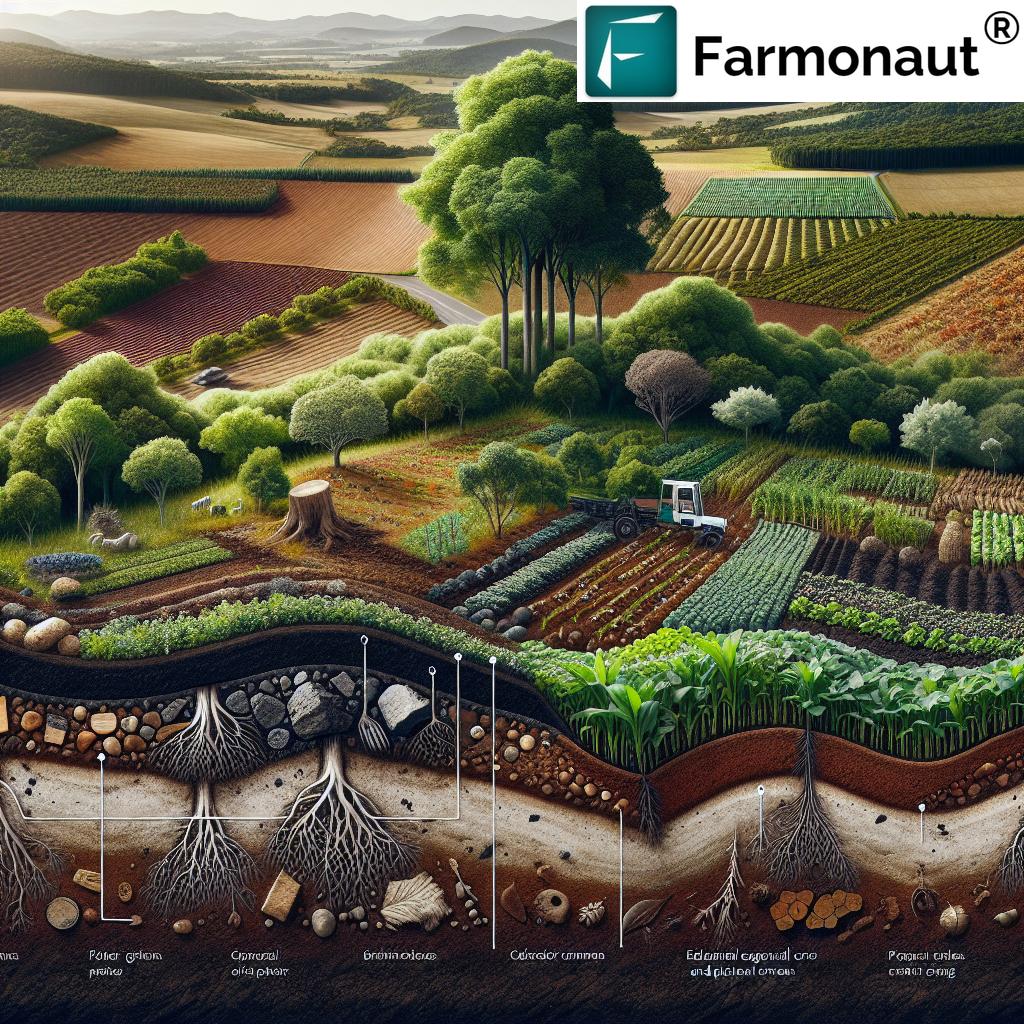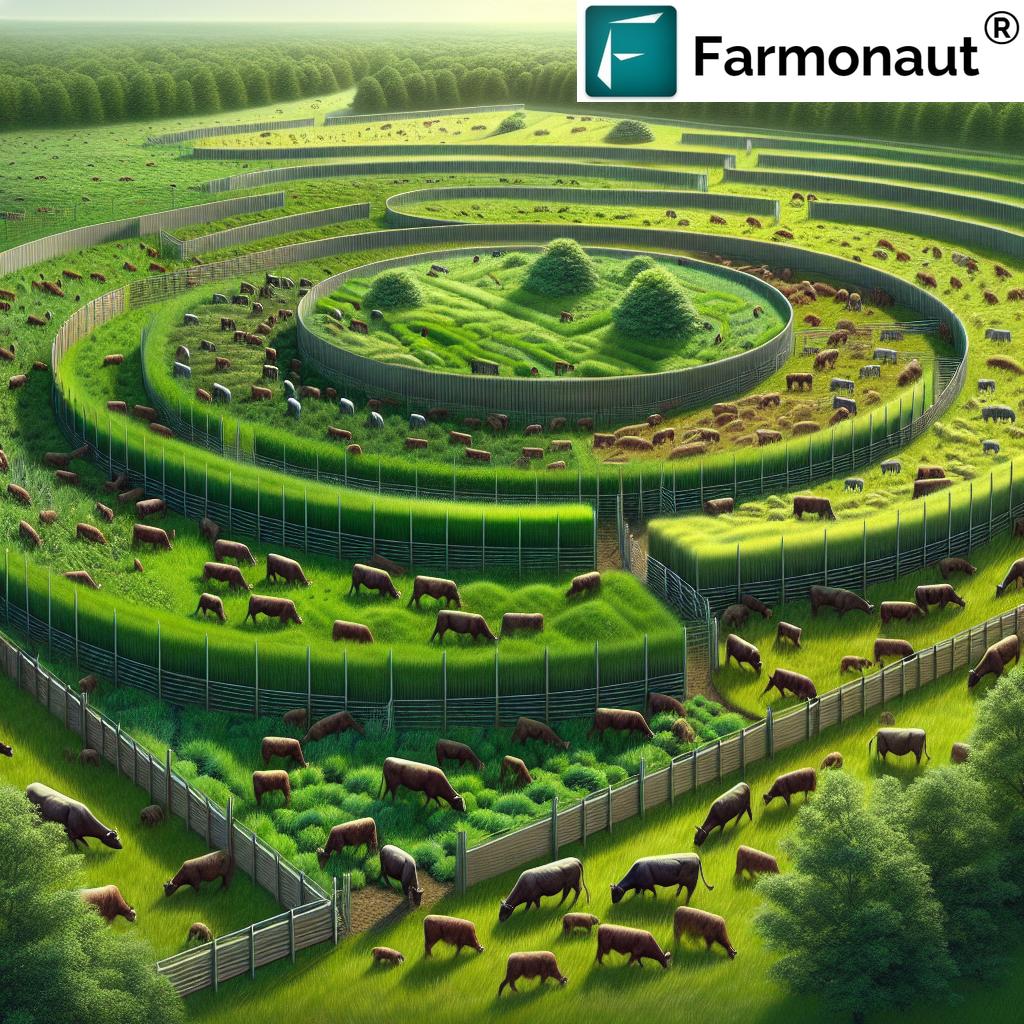Organic Carbon in Soil: 7 Ways to Boost Health & Climate
“Soil organic carbon can increase crop yields by up to 20% with sustainable farming practices.”
“Globally, soils store over 2,500 gigatons of carbon—more than three times the carbon in the atmosphere.”
Introduction: The Power of Soil Organic Carbon
Soil organic carbon (SOC) is at the heart of global soil health and productivity, shaping the planet’s ability to nourish crops, support ecosystems, and act as a vital buffer in the battle against climate change. As the principal component of soil organic matter (SOM), SOC not only drives nutrient cycling and soil fertility but also represents the world’s largest terrestrial carbon pool—far surpassing the carbon stored in both the atmosphere and vegetation.
Through natural processes including organic matter decomposition, soils absorb and store carbon, contributing significantly to climate regulation and agricultural prosperity. Understanding soil organic carbon—its formation, influencing factors, and how to boost its content through sustainable practices—is essential for farmers, land managers, researchers, and policy makers striving for sustainability and food security.
Formation and Composition of Soil Organic Carbon (SOC)
The origins and complexities of soil organic carbon are crucial for understanding how to enhance soil health and carbon sequestration in agriculture. SOC arises primarily from the decomposition of plant residues, animal remains, and microbial biomass. These inputs go through a transformative process—breaking down into various fractions that determine both the structure and fertility of the soil.
Let’s break down the main components and fractions of SOC:
- Particulate Organic Carbon (POC): Consists of larger, less decomposed organic matter originating from recently added plant and animal materials. POC is dynamic, contributing immediately to fertility and acting as a ready source of nutrients.
- Mineral-Associated Organic Carbon (MAOC): Formed when carbon binds with soil minerals (such as clays and silts), creating a more stabilized fraction. MAOC offers significant resistance to decomposition—playing a key role in carbon sequestration and protecting SOC from rapid loss.
The balance between POC and MAOC determines the potential of soils to support high soil health and productivity while contributing to climate change mitigation practices.
Factors Influencing Soil Organic Carbon Levels
Soil organic carbon levels do not occur in isolation. A range of factors interact dynamically, shaping SOC content and stability in every field:
- Climate Patterns: Temperature and precipitation rates influence the speed of organic decomposition and inputs from vegetation. Warm, wet conditions often accelerate breakdown of organic matter, while cooler or drier climates slow it down, promoting accumulation.
- Soil Type & Texture: The texture (proportion of sand, silt, and clay) and specific mineral composition of soils strongly determine SOC stability. Fine-textured soils, with higher clay content, typically allow for greater stabilization of organic carbon compared to sandy soils.
- Land Management Practices: Modern agricultural systems, forestry management, and grazing can all drastically alter SOC dynamics—determining both depletion and build-up.
Key Factors Affecting Soil Carbon Levels in Practice:
- Regions with variable rainfall patterns require adaptive approaches to sustaining SOC.
- The impact of tillage on soil carbon is significant—intensive tillage practices can deplete SOC rapidly.
- Implementing organic amendments for soil fertility helps balance SOC even in challenging climates and soil types.
Impact of Agricultural Practices on Soil Organic Carbon
Modern agricultural activities can be a double-edged sword—they may drive depletion of soil organic carbon or serve as powerful levers to boost SOC levels, depending on adopted practices.
High-impact Land Management Practices
-
No-Till Farming:
- Reduces soil disturbance and erosion.
- Encourages higher organic matter accumulation.
-
Studies indicate: No-till systems can increase SOC by approximately 9.3%.
(Evidence source)
-
Cover Cropping:
- Maintains constant plant cover during off-seasons, providing ongoing organic inputs via residues.
- Improves soil structure, enhances microbial activity, and protects against erosion and nutrient loss.
-
Cover cropping benefits are magnified when combined with no-till—maximizing carbon sequestration in agriculture.
(Learn more)
-
Organic Amendments:
- Application of compost, manure, and other organic fertilizers boosts organic matter content, supporting SOC increments.
-
Meta-analyses indicate: Organic farming methods—amendments included—enhance SOC by up to 18% relative to conventional approaches.
(Meta-analysis reference)
These methods together enhance soil health and productivity, offering robust resistance against erosion, supporting nutrient cycling, and providing a vital tool for climate mitigation.
More on Impact of Tillage on Soil Carbon:
- Tillage breaks apart soil aggregates, exposing organic carbon to rapid decomposition—a primary driver of SOC loss in conventional farming.
- No-till and conservation tillage help maintain SOC fractions within the topsoil, guarding against erosion and carbon release.
Learn more about how you can automate and optimize your carbon monitoring with Farmonaut’s carbon footprinting tool, ideal for tracking emissions and implementing sustainable practices at scale.
Forestry Practices and Soil Organic Carbon
Beyond farming, forestry practices shape the global cycling and storage of soil organic carbon. Soils under forests often contain some of the highest SOC stocks on earth—vital for regulation of atmospheric CO₂ and safeguarding terrestrial carbon pools.
Agroforestry and Carbon Storage
- Agroforestry: The integration of trees within agricultural systems—combining crops, livestock, and woody perennials—results in enhanced carbon sequestration and improved soil health.
- Studies consistently indicate that agroforestry increases SOC stocks, promotes climate resilience, and brings additional benefits for smallholder farmers (Learn more).
Impact of Deforestation on Soil Organic Carbon
- When forests are converted to cropland, substantial SOC loss occurs.
- Replacing forests with agriculture can reduce soil carbon stocks by 24–52% (Reference).
- Sustainable management and reforestation efforts are essential for mitigation and long-term soil fertility.
Discover how Farmonaut’s advisory tools help optimize agroforestry, guiding practitioners on best planting periods, healthy forest structure, and efficient resource management.
Soil Organic Carbon & Climate Change Mitigation
Improving soil organic carbon levels is not only vital for land health and farm productivity—it is a cornerstone of climate change mitigation practices at the global scale.
- Soils act as carbon sinks: Sequestering atmospheric CO₂ and offsetting greenhouse gas emissions.
-
Enhanced weathering and amendments: Large-scale field trials in the U.S. Corn Belt show the power of basalt application for cumulative carbon sequestration of 15.4 ± 4.1 t CO₂ ha⁻¹ over four years, along with increased yields.
(Details on basalt trials) - Greater SOC, greater stability: Higher SOC supports improved water retention, stronger soil aggregates, and yields more resilient against drought and erosion.
Soil Health and Productivity
- Stable organic carbon: Forms the bedrock for microbial diversity and nutrient cycling, underlining both immediate productivity and long-term sustainability.
- Organic amendments for soil fertility not only raise SOC, but also promote biodiversity, increase nutrient availability, and buffer crops against weather extremes.
“Soil organic carbon can increase crop yields by up to 20% with sustainable farming practices.”
“Globally, soils store over 2,500 gigatons of carbon—more than three times the carbon in the atmosphere.”
7 Ways to Boost Soil Organic Carbon for a Healthier Climate
To enhance SOC, farmers, foresters, and land managers should focus on proven, research-backed practices that maximize sequestration, fertility, and farm resilience. Here are seven leading methods and their specific benefits:
- Reduce Tillage: Minimize soil disturbance to protect existing carbon and support ongoing organic matter accumulation.
- Cover Cropping: Plant cover crops on fallow land during off-seasons to add organic residues, enrich microbial activity, and guard against erosion.
- Apply Organic Amendments: Use compost, manure, and green residues to feed soil biology, increase SOC levels, and accelerate nutrients cycling.
- Agroforestry: Integrate trees and perennials within cropping or grazing systems to multiply carbon storage, diversify farm income, and improve microclimates.
- Adaptive Grazing Management: Rotate and optimize grazing intensity to minimize bare soil and maintain high root biomass.
- Residue Retention: Leave crop residues on the field after harvest to improve soil structure and promote carbon stabilization.
- Enhanced Weathering: Apply finely crushed silicate minerals (such as basalt) to accelerate carbon capture via mineral association, particularly on acidic soils.
Combining these practices not only shields soils from depletion, but also restores their role as dynamic carbon sinks.
Comparison Table: Sustainable Practices & SOC Impact
| Sustainable Practice | Estimated Increase in Soil Organic Carbon (%) |
Impact on Soil Health |
Change in Crop Yield (%) | Estimated Carbon Sequestration (tons/ha/year) |
|---|---|---|---|---|
| Cover Cropping | 7–14% | Improves structure, boosts biological life | 5–15% | 0.3–1.5 |
| Reduced/No-Tillage | 8–12% | Reduces erosion, preserves aggregates | 5–10% | 0.2–1.0 |
| Organic Amendments (Compost/Manure) |
12–18% | Boosts fertility, increases microbial biomass | 8–20% | 0.5–2.0 |
| Agroforestry | 12–30% | Enhances stability, supports water retention | 8–25% | 1.0–3.0 |
| Adaptive Grazing | 5–10% | Reduces compaction, increases SOC retention | 3–8% | 0.2–1.2 |
| Residue Retention | 6–13% | Protects against erosion, enhances rooting | 4–12% | 0.3–1.0 |
| Enhanced Weathering | 8–18% | Boosts MAOC formation | 10–19% | 2.0–5.0 |
Tip: Employing multiple practices yields synergistic results, maximizing carbon storage, resilience, and crop value. Use smart monitoring tools such as Farmonaut’s satellite platform for real-time insights into soil health and the effectiveness of your management strategy.
Challenges & Considerations in Enhancing SOC
Despite well-established methods, several challenges must be addressed to ensure widespread adoption and lasting impact of SOC-enhancing practices:
- Measurement & Monitoring: SOC changes often occur gradually. Standardized methods and long-term, high-resolution data are essential for accurate assessment.
- Economic Factors: Upfront investment for some farmers—such as seed for cover crops or composting infrastructure—can be a barrier, especially in resource-constrained regions.
- Policy Support: Government and institutional policies must offer clear incentives and technical resources to encourage the switch to sustainable land management.
Why Monitoring Matters
Implementing any SOC strategy is only effective when results are measurable and visible.
- Farmonaut users get real-time soil carbon and vegetation data at the field, regional, or country scale, making it easier for farmers and organizations to track progress, comply with standards, and quantify benefits.
For open access, developers, and integration, explore the Farmonaut API and Developer Documentation.
How Farmonaut Empowers Precision & Sustainable Agriculture
As sustainable agricultural management and carbon sequestration in agriculture become central to future food systems, digital solutions are transforming efficiency, transparency, and impact tracking.
We at Farmonaut offer advanced, affordable satellite-driven farm management tools across Android, iOS, web, and API. Our real-time crop health monitoring and AI-based analysis help farmers, agribusinesses, and policy makers optimize soil health and carbon outcomes. Our platform maps vegetation, monitors soil moisture, detects changes in organic carbon levels, and generates custom advisories to improve productivity while reducing environmental impact.
- Blockchain Traceability: Ensures complete transparency for agricultural supply chains. Read more about transparency in agriculture at the Product Traceability page.
- Fleet & Resource Management: Our tools help optimize farm logistics and reduce unnecessary emissions. Learn more about maximizing efficiency here.
- Crop Loan & Insurance: Satellite verification simplifies access to credit and insurance for farmers. Details are available on our Crop Loan & Insurance page.
- Large-Scale Farm Management: Custom analytics for governments and big farms to plan and track sustainability programs (see solutions).
Our solution integrates seamlessly with any farm type, enabling the adoption of climate-smart farming practices for maximized soil organic carbon sequestration and resilience.
FAQ: Soil Organic Carbon & Sustainable Farming
What is soil organic carbon and why is it important?
Soil organic carbon (SOC) is the carbon component found in soil organic matter (SOM), originating from decomposed plant, animal, and microbial materials. SOC sustains soil structure, fertility, and is a major player in global carbon cycling—making it essential for crop productivity and climate mitigation.
What factors affect soil organic carbon levels?
Climate (temperature, rainfall patterns), soil type (texture, mineral content), management practices (tillage, residue retention), and land use (forestry, cropping) all impact SOC levels.
How does tillage impact soil carbon?
Tillage disrupts soil aggregates, accelerates decomposition of organic matter, and leads to significant carbon losses. Reducing tillage helps stabilize and build soil carbon over time.
Which practices are most effective for increasing SOC?
Cover cropping, reduced/no-till, application of organic amendments, agroforestry, adaptive grazing, crop residue retention, and enhanced weathering are all proven methods for increasing SOC.
How does agroforestry enhance soil organic carbon and climate resilience?
Agroforestry integrates trees within agricultural landscapes, increasing carbon inputs from both roots and above-ground biomass, enhancing soil structural stability, biodiversity, and resilience to extreme weather.
How can technology help me track soil organic carbon?
Technologies such as Farmonaut’s satellite imagery, AI-based monitoring, and digital advisory services enable real-time tracking of SOC, crop health, and overall soil condition, supporting evidence-based management decisions.
Are there economic barriers to increasing SOC?
Initial investments in seeds, amendments, and training can be barriers for some farmers, but long-term increases in yield, resource efficiency, and farm resilience often outweigh these costs.
Conclusion: Future of SOC, Climate, & Agriculture
Soil organic carbon is more than just a soil property—it is a lifeline for the world’s food security, climate stability, and farm profitability. By adopting sustainable management practices, employing state-of-the-art digital monitoring tools, and focusing on both short-term productivity and long-term resilience, farmers and land managers can unlock the full potential of soils as carbon sinks and engines of productivity.
We invite you to join the revolution in soil health and climate-friendly agriculture:
- Adopt proven SOC-building practices—from cover crops to agroforestry to organic amendments.
- Track your progress digitally with Farmonaut’s AI-powered monitoring tools.
- Advocate for supportive policies and fair incentives for sustainable land stewardship.
Together, we can build healthier farms, more productive soils, and a sustainable future for all. Empower your journey with Farmonaut—download the app or visit our platform today.












